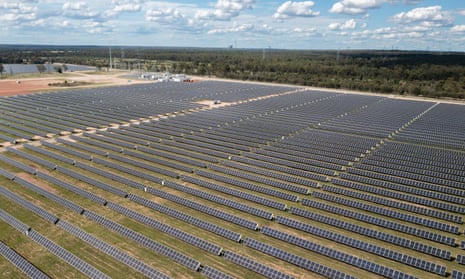Extract from The Guardian

The Western Downs green power hub solar farm in Queensland. The state government is launching a Renewable Energy Zone Roadmap to manage its $1bn renewables rollout
Exclusive: gas commission to play key role, with reference groups created comprising landholders, councils, cultural representatives and consumers.
Tue 26 Mar 2024 06.00 AEDT
Last modified on Tue 26 Mar 2024 07.33 AEDTThe Queensland government is launching a plan to use the gas commission and local consultation bodies to help maintain land-use harmony during the state’s $1bn renewables build-out.
The energy minister, Mick de Brenni, is expected to launch the Queensland Renewable Energy Zone Roadmap at an industry event on Tuesday.
Under the scheme, the government plans to create a local reference group for each of the state’s 12 renewable energy zones. The groups will place landholders, councils, cultural representatives and energy consumers at the core of planning for the rollout of renewables.
The first reference groups will begin operation this year, with Callide likely to be the first officially declared zone.
GasFields Commission Queensland is expected to be granted an expanded remit to advise on challenges to coexistence across all energy projects and help coordinate energy planning.
“The REZ Roadmap paves a clear way forward to ensure all regions of the state benefit from the economic and investment opportunities renewable energy brings,” De Brenni said.
“We’re taking intentional, measured steps to deliver a clear and detailed framework, which has never been rolled out in Australia on this scale before.
“The energy transition is all about supporting regional communities – and with this groundbreaking plan, we’re putting those communities and the people who call them home, first.”
The independent statutory body was created in 2013 to help manage conflicts with the state’s expanding coal seam gas industry.
Land use conflict has emerged as a major flashpoint during the green energy transition.
The government is also expected to establish an assessment process to identify potential roadblocks in a region, in advance of the declaration of an energy zone.
The REZ readiness assessment process would investigate a range of issues, including transport, housing and accommodation, waste management, environmental challenges, as well as local industry and First Nations considerations.
“Regional Queensland is crucial to ensuring Queensland reaches its renewable energy targets and we are committed to backing local communities and delivering them the best outcomes as part of this transition,” De Brenni said.
“We’ve listened to local communities in the design of this process from the beginning to ensure we provide the support they need and deliver the benefits they want, and I acknowledge regional mayors, like Nev Ferrier of Banana shire, for their advocacy.”
The government will also undertake a review into how it can better manage community feedback about large-scale energy infrastructure development.
Queensland will eventually have about 22GW of solar, wind and hydroelectric power generation capacity. By 2035, 80% of the state’s energy production will be green power.
The government plans to bring legislation setting the energy transition in law mid-year.
No comments:
Post a Comment